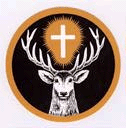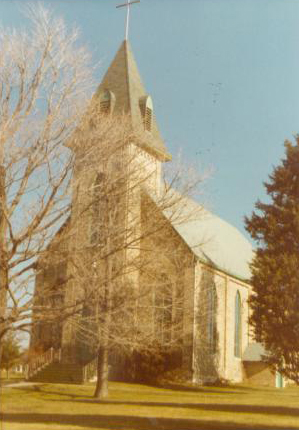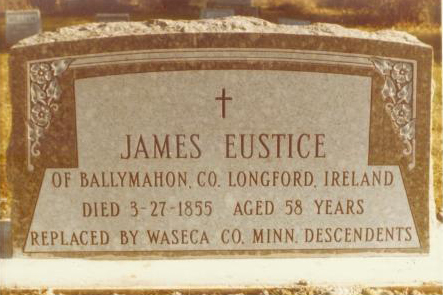|
Mapleton, Waukesha County, Wisconsin
Editors note: The history
of Mapleton is mentioned in the History of Waukesha County, Wisconsin (1880). A
history of Mapleton, Wisconsin was written in 1978 by Maureen Kuehn and
published in the History of the Parish of St, Catherine of Alexandria. Although
there have been changes in the past century, and during the past three decades,
these documents clearly show the "flavor" of the families who have been a vital
part of the Catholic Parish of St. Catherine of Alexandria and the village of
Mapleton, Wisconsin. The first blacksmith shop was started by Messrs. Whitehall & Jerenson, who used Mr. Breck's storeroom for the purpose, but during the year a fire destroyed the building and contents. The next shop was started by Mr. (Christopher) Jewison Hans Larsen kept the first shoe shop in Mapleton. The only hotel was kept by Mr. Borneman. The first schoolhouse was built in 1849, on a lot donated by Mr. Breck. It was frame and was considered quite "nobby” at that time, as most of the school houses in the country were built of logs. But in the course of time, it became too small for the rising generation, and a new one was built which is a credit to the community. It is 28x68, brick, well finished inside and outside. It is furnished with ventilators, plenty of light, high ceilings, and is also supplied with good furniture. In early days, the post office was at Delafield, and the neighbors would club together and get the mail by turns about once in two or three weeks. In 1851, Samuel Breck became the first Postmaster, and in 1855, George Sterzbach succeeded him. In 1859, Anthony Hauser succeeded Mr. Sterzbach, and has been Post Master ever since. A Catholic Church is a short distance from here, on land donated by Alexander Coyle. Adjoining it is also a cemetery belonging to the church. The resident priest in 1880 was Reverend M. Monaghan. At that time, there were about seventy families belonging to the parish. Or those who still reside in the town, who came before 1850, are George Williams, Charles B. Sheldon, Thomas Salter, John Daily, Ethan Daily, John Ferry, George Ferry, Curtis B. Brown, John Whittaker, Jens Forra, John Forra, Charles J. Strohn, Francis Nugent, Alexander Madole, Joseph Counsell, John Counsell, Henry Baker, Michael Manny, Thomas Burns, John Burns, Henry Burns, John Kinnie, Alexander Coyle, Peter Coyle, Peter Brierton, Moses Clemens, Gilbert Dopp, Benjamin Dopp, Hiram Proseus, Charles Tremain, Joseph Tremain, William Radcliff, Thomas Whalen, Edward Whalin, George Hatch, Thomas Ireland, Daniel Hatch, John Truesdell, William Travis, Frederick Blake, Amos Townsend, David Hastings, James K. Wood, Charles Thompson, John Gaghan, William Chaffee, George Fulmer, William Olson, James Doran, John Meyers, Smith Hastings, Horace Hastings, and perhaps a few others. History of Waukesha County, Wisconsin (1880); WEisconsin Historical Society, Madison Call Number F902W4H67.
ditors note: The
history of Mapleton is mentioned in the History of Waukesha County, Wisconsin
(1880). A history of Mapleton, Wisconsin was written in 1978 by Maureen Kuehn
and published in the History of the Parish of St, Catherine of Alexandria.
Although there have been changes in the past century, and during the past three
decades, these documents clearly show the "flavor" of the families who have been
a vital part of the Catholic Parish of St. Catherine of Alexandria and the
village of Mapleton, Wisconsin. The first blacksmith shop was started by Messrs. Whitehall & Jerenson, who used Mr. Breck's storeroom for the purpose, but during the year a fire destroyed the building and contents. The next shop was started by Mr. (Christopher) Jewison Hans Larsen kept the first shoe shop in Mapleton. The only hotel was kept by Mr. Borneman. The first schoolhouse was built in 1849, on a lot donated by Mr. Breck. It was frame and was considered quite "nobby” at that time, as most of the school houses in the country were built of logs. But in the course of time, it became too small for the rising generation, and a new one was built which is a credit to the community. It is 28x68, brick, well finished inside and outside. It is furnished with ventilators, plenty of light, high ceilings, and is also supplied with good furniture. ,. . In early days, the post office was at Delafield, and the neighbors would club together and get the mail by turns about once in two or three weeks. In 1851, Samuel Breck became the first Postmaster, and in 1855, George Sterzbach succeeded him. In 1859, Anthony Hauser succeeded Mr. Sterzbach, and has been Post Master ever since. A Catholic Church is a short distance from here, on land donated by Alexander Coyle. Adjoining it is also a cemetery belonging to the church. The resident priest in 1880 was Reverend M. Monaghan. At that time, there were about seventy families belonging to the parish.
Or those who still reside in the
town, who came before 1850, are George Williams, Charles B. Sheldon, Thomas
Salter, John Daily, Ethan Daily, John Ferry, George Ferry, Curtis B. Brown, John
Whittaker, Jens Forra, John Forra, Charles J. Strohn, Francis Nugent, Alexander
Madole, Joseph Counsell, John Counsell, Henry Baker, Michael Manny, Thomas
Burns, John Burns, Henry Burns, John Kinnie, Alexander Coyle, Peter Coyle,
Peter Brierton, Moses Clemens, Gilbert Dopp, Benjamin Dopp, Hiram Proseus,
Charles Tremain, Joseph Tremain, William Radcliff, Thomas Whalen, Edward Whalin,
George Hatch, Thomas Ireland, Daniel Hatch, John Truesdell, William Travis,
Frederick Blake, Amos Townsend, David Hastings, James K. Wood, Charles
Thompson, John Gaghan, William Chaffee, George Fulmer, William Olson, James
Doran, John Meyers, Smith Hastings, Horace Hastings, and perhaps a few others.
History of Waukesha County, Wisconsin (1880); WEisconsin Historical Society,
Madison Call Number F902W4H67. Two types of Irish settled in the Mapleton area. Those who settled more to the north were "orange" Irish, while those who settled closer to Mapleton were "green". The Protestant and Catholic Irish were often playing nasty tricks upon one another; For instance, if an "orange" Irishman happened to be going down the road with a load of hay, a "green" Irishman would: come along from behind and. Help the gentleman, to lighten his load prematurely, with a lit match. The original town of Mapleton was first located and settled east of the present town's site, in 1843 and 1844. About sixteen English families under the guidance of a Mr. Samuel Breck, helped to encourage settlement by building houses, which were then sold at low prices to bring more people to the area. Through the aid of Mr. Breck, the town eventually contained a grist mill, shoe shop, blacksmith shop, store, hotel and school. This original Mapleton probably contained from thirty to forty houses, all or most of which are now gone. Since most of these settlers; were English there seems to have been few Catholics among them. Eventually surrounding farms sprang up to the west of the town. . Most of these farmers were Irish Catholic, and the core of their area became known as "Coyle's Settlement", the present site of what is today the town of Mapleton. The earlier English site may have been known by a name other than Mapleton, because there seems to be a story behind the name "Mapleton" which has not been confirmed. Around the turn of the century, it seems, the cemetery and parish grounds were landscaped under the direction of Father McCarthy (1895-1912). At that time many, of the trees planted were maples which gave the town its name.
Names to remember: Coyle, Brierton
and Madole:
Where church's name came from: The Irish who settled in this area seemed to know more about the land than previous Irish. They were excellent farmers and settled on good land, so that only two or three days a week were actually needed to work. The Irish were anchored to Mapleton by the church and the mill. They helped to start a school, because they knew the value of an education and felt that they had been robbed of schooling, and would not have their children without an education, were Maples, thus giving Mapleton its name.The Irish who settled in Wisconsin came as individuals rather than in groups. The earliest immigrants tended to remain in the larger urban centers, instead of moving into more rural areas. They were anxious not lose touch with the Church. The first eight pastors of St. Catherine's came from Ireland; they were dedicated to their faith and made sure the people held to it: These priests came to fulfill the needs of the Catholic Irish so that the people could be rural and at the same time feel secure that in being rural, they did not have to lose touch with the Church. Before 1850 there were two streams of Irish immigrants moving into Wisconsin. One from the southwest and the other through the Milwaukee harbor, which became the focal point for disembarkation, The largest migrations were initialed by the 1846 potato famine, and the "rack rent'*" they had to pay to absentee landlords. By1850, there were 21,000 natives of Ireland in Wisconsin; three-fourths of whom had arrived during territorial days. Many Irish came down from Canada, through the Great Lakes and into Milwaukee. From Milwaukee, the Irish spread north into farming areas and started their own wholly Irish communities. Though, over time the Germans have eventually moved in, so that these settlements are not as Celtic as they once were. Two types of Irish settled in the Mapleton area. Those who settled more to the north were "orange" Irish, while those who settled closer to Mapleton were "green". The Protestant and Catholic Irish were often playing nasty tricks upon one another; For instance, if an "orange" Irishman happened to be going down the road with a load of hay, a "green" Irishman would: come along from behind and. Help the gentleman, to lighten his load prematurely, with a lit match. The original town of Mapleton was first located and settled east of the present town's site, in 1843 and 1844. About sixteen English families under the guidance of a Mr. Samuel Breck, helped to encourage settlement by building houses, which were then sold at low prices to bring more people to the area. Through the aid of Mr. Breck, the town eventually contained a grist mill, shoe shop, blacksmith shop, store, hotel and school. This original Mapleton probably contained from thirty to forty houses, all or most of which are now gone. Since most of these settlers; were English there seems to have been few Catholics among them. Eventually surrounding farms sprang up to the west of the town. . Most of these farmers were Irish Catholic, and the core of their area became known as "Coyle's Settlement", the present site of what is today the town of Mapleton. The earlier English site may have been known by a name other than Mapleton, because there seems to be a story behind the name "Mapleton" which has not been confirmed. Around the turn of the century, it seems, the cemetery and parish grounds were landscaped under the direction of Father McCarthy (1895-1912). At that time many, of the trees planted were maples which gave the town its name.
Names to remember: Coyle, Brierton and Madole:
Where church's name came from:
The Irish who settled in this area seemed to know more about the land than previous Irish. They were excellent farmers and settled on good land, so that only two or three days a week were actually needed to work. The Irish were anchored to Mapleton by the church and the mill. They helped to start a school, because they knew the value of an education and felt that they had been robbed of schooling, and would not have their children without an education, were Maples, thus giving Mapleton its name. |
|||||||||||||


